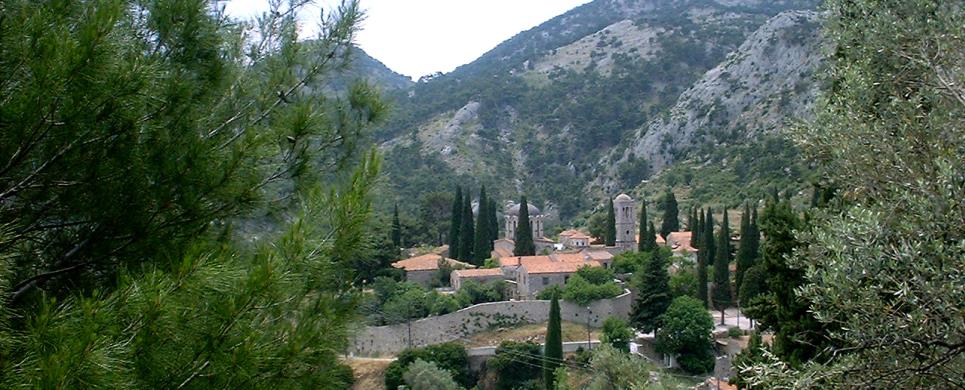Εμφανίζονται 3 τίτλοι με αναζήτηση: Προσκυνήματα στην ευρύτερη περιοχή: "ΝΕΑ ΜΟΝΗ Μοναστήρι ΧΙΟΣ" .

ΝΕΑ ΜΟΝΗ (Μοναστήρι) ΧΙΟΣ
Τηλέφωνο: +30 22710 79391, 79370
Ακολουθώντας τον ανηφορικό δρόμο που οδηγεί προς το κέντρο του νησιού και δυτικά της πρωτεύουσας, ανάμεσα σε δάση και πηγαία τρεχούμενα νερά, φθάνουμε στο μοναστηριακό συγκρότημα της Νέας Μονής. Βρίσκεται σε σημείο με εξαιρετική θέα μεταξύ της δυτικής και ανατολικής ακτής προς τα Μικρασιατικά παράλια και σε απόσταση 15 χλμ από τη Χώρα.
Είναι το πιο σπουδαίο από τα μοναστήρια του νησιού και μνημείο διεθνούς σημασίας. Θεωρείται μεγαλούργημα της καλλιτεχνίας και έχει αποτιμηθεί «ως ίσον ταις πρωτίσταις οικοδομαίς των επτά θαυμάτων». Κτίσθηκε επάνω στο Προβάτειο ´Ορος στη μέση του σχηματισμού της νήσου σε σχήμα Χ από τον Κωνσταντίνο το Μονομάχο. Κατά την παράδοση ανεγέρθηκε στο σημείο όπου βρέθηκε η εικόνα της Θεοτόκου από τους τρεις ασκητές Νικήτα, Ιωάννη και Ιωσήφ άκαυστη μέσα σε καιόμενη μυρσίνη.
Το γεγονός συνέπεσε με την εξορία του Κωνσταντίνου του Μονομάχου στη Λέσβο. Θέλημα της Παναγίας, όμως, ήταν να επανέλθει ο Μονομάχος ως αυτοκράτορας στη Βασιλεύουσα· αυτό ήταν το αποκαλυπτικό όραμα των τριών ασκητών, οι οποίοι έσπευσαν στη Μυτιλήνη για να το γνωστοποιήσουν στον Κωνσταντίνο. Ο εξόριστος αυτοκράτορας χάρηκε με την πρόρρηση των μοναχών και τους υποσχέθηκε, σε ένδειξη ευγνωμοσύνης, να κτίσει στο σημείο εύρεσης της εικόνας μεγαλοπρεπή ναό για τη Βασίλισσα των Oυρανών, όπως ήταν η επιθυμία τους. Για να είναι όμως σίγουροι οι μοναχοί και να έχουν τη δυνατότητα να υπενθυμίσουν στον Μονομάχο την υπόσχεσή του, ζήτησαν και πήραν μαζί τους το αυτοκρατορικό χρυσόβουλλο δαχτυλίδι του.
Η προφητεία των τριών μοναχών εκπληρώθηκε, όταν στο θρόνο του Βυζαντίου ανήλθε το 1042 η Ζωή, η οποία ανακάλεσε από την εξορία τον Μονομάχο και με νόμιμο γάμο τους τον ανεκήρυξε επίσημα αυτοκράτορα. Όταν οι μοναχοί πληροφορήθηκαν το γεγονός ταξίδεψαν στη Κωνσταντινούπολη και ζήτησαν από τον αυτοκράτορα, δείχνοντάς του το δακτυλίδι σημαντήρα, την τήρηση της υπόσχεσής του.
Ο Κωνσταντίνος τήρησε με γενναιοδωρία τις υποσχέσεις του. Πρότεινε μάλιστα στους μοναχούς να περιηγηθούν τη Βασιλεύουσα και να διαλέξουν όποιο σχέδιο ναού επιθυμούν, εκτός από εκείνον της Αγίας του Θεού Σοφίας. Κατά μία εκδοχή οι ασκητές διάλεξαν το σχέδιο του Ναού των Αγίων Αποστόλων, αριστούργημα τέχνης, κτισμένο την εποχή του Ιουστινιανού τον 6ο μ.Χ. αιώνα. Σύμφωνα με τα αρχιτεκτονικά δεδομένα, το Καθολικό της Νέας Μονής κτίσθηκε με πρότυπο το Ναό των Αγίων Σεργίου και Βάκχου της Κωνσταντινούπολης, χωρίς να είναι γνωστοί οι λόγοι για τους οποίους δεν εκπληρώθηκε η αρχική επιθυμία τους.
Η οικοδόμηση του Καθολικού άρχισε στο τέλος του 1042 ή αρχές του 1043 και κράτησε δώδεκα χρόνια με βασιλικές μισθοφορίες και δαπάνες «του βασιλέως έτι ζώντος». Ο Μονομάχος όχι μόνο κάλυψε όλες τις δαπάνες για την κατασκευή της Μονής, αλλά έστειλε από τη Βασιλεύουσα στη Χίο έναν κορυφαίο αρχιτέκτονα - του οποίου το όνομα δεν αναφέρεται πουθενά - και πολύτιμο υλικό, ό,τι πιο εκλεκτό διέθετε η αυτοκρατορία.
Ολόκληρο το μοναστηριακό συγκρότημα της Νέας Μονής κείται μέσα σε πευκόφυτη χαράδρα του Προβατείου ´Ορους σε ανώμαλο τραπεζοειδές σχήμα με θέα προς τη θάλασσα. Αποτελείται από πολυάριθμα κτίσματα: το Καθολικό, την Τράπεζα, την Κινστέρνα, τον Πύργο, το Καμπαναριό, τη Βιβλιοθήκη, τα Κελιά, το Τρίκλινο και τα δύο παρεκκλήσια, του Αγίου Παντελεήμονα και του Τιμίου Σταυρού. Σαφή εικόνα για ολόκληρο το μοναστηριακό συγκρότημα έχουμε από την περιγραφή και τα σχεδιάσματα του Ρώσου μοναχού και αγιογράφου Βασίλη Μπάρσκυ, ο οποίος αφού επισκέφθηκε πέντε φορές τη Χίο, περιέγραψε και σχεδίασε τη Μονή κατά την εξάμηνη παραμονή του σε αυτή το 1705.
Στο κέντρο των κτισμάτων βρίσκεται το Καθολικό, πoυ είναι αφιερωμένο στην Κοίμηση της Θεοτόκου. Ο αρχιτεκτονικός του τύπος είναι ελλαδικός, οκταγωνικός, και αποτελεί το σπουδαιότερο υπόδειγμα του λεγόμενου νησιώτικου οκταγωνικού τύπου ναού, γνωστού μόνο στη Χίο και την Κύπρο. Η στήριξη του τρούλου είναι οκταγωνική, ενώ ο κυρίως ναός παραμένει τετράγωνος, απλός χωρίς εξωτερικά στηρίγματα. Στο τετράγωνο της κάτοψης έρχονται να προστεθούν το τριμερές και καμαροσκέπαστο ιερό και οι δύο νάρθηκες.
Η
Νέα Μονή, μνημείο διεθνούς σημασίας, ιδρύθηκε στα μέσα του 11ου αιώνα με χορηγία
του αυτοκράτορα Κωνσταντίνου Θ' Μονομάχου και της συζύγου του Ζωής. Για αιώνες
αποτέλεσε το σπουδαιότερο θρησκευτικό κέντρο της Χίου. Τον 19ο αιώνα υπέστη πολλές
καταστροφές. Συγκεκριμένα το 1822 λεηλατήθηκε από τους Τούρκους και με τον καταστροφικό
σεισμό του 1881 κατέρρευσαν ο τρούλος, το κωδωνοστάσιο, η καμάρα του ιερού στο
Καθολικό, ενώ πολλά από τα ψηφιδωτά
έπαθαν μεγάλες ζημιές. Κατά καιρούς έχουν πραγματοποιηθεί προσπάθειες αναστήλωσης
του μοναστηριού και συντήρησης των ψηφιδωτών
του Καθολικού.
Το Καθολικό της μονής αποτελεί το σπουδαιότερο παράδειγμα του νησιωτικού
οκταγωνικού τύπου και είναι διακοσμημένο με ψηφιδωτά. Η τράπεζα της μονής βρίσκεται
στα ΝΔ του καθολικού ενώ στο δυτικό άκρο της μονής δεσπόζει ο αμυντικός Πύργος.
Στον 11ο αιώνα ανάγεται και η ημιυπόγεια Κινστέρνα η οποία έχει διατηρηθεί άθικτη.
Τα κελλιά της μονής, τα οποία είναι νεώτερα, βρίσκονται σχεδόν στο σύνολό τους
σε ερειπιώδη κατάσταση. Το μοναστήρι περιβάλλεται από - ακανόνιστο στο σχήμα -
λιθόκτιστο περίβολο.
Το έτος 1857 πραγματοποιήθηκαν εκτεταμένες εργασίες στο Καθολικό από
τον ηγούμενο της Μονής Γρηγόριο Φωτεινό, που αλλοίωσαν σημαντικά την μορφή του.
Το 1900 αντικαταστάθηκε ο τρούλος του καθολικού, που κατέρρευσε με τον σεισμό
του 1881. Στην δεκαετία του 1960 πραγματοποιήθηκαν εργασίες συντήρησης των ψηφιδωτών.
Έκτοτε συνεχίζονται οι εργασίες αναστήλωσης στα διάφορα κτίσματα του μοναστηριακού
συγκροτήματος.
Σήμερα η Νέα
Μονή λειτουργεί ως γυναικείο μοναστήρι, ενώ στα ΒΔ του Καθολικού, ένα διώροφο
κτήριο κελλιών έχει μετασκευασθεί και λειτουργεί ως Μουσείο
των κειμηλίων της Μονής. Από το 1995, η 3η Εφορεία Βυζαντινών Αρχαιοτήτων πραγματοποιεί
εκπαιδευτικά προγράμματα στη Μονή, για μαθητές σχολείων ηλικίας 12 - 18 ετών.
Το μοναστήρι της Νέας Μονής Χίου, έχει εγγραφεί στον Κατάλογο των Μνημείων Παγκόσμιας
Πολιτιστικής Κληρονομιάς της UNESCO.
Το κείμενο παρατίθεται τον Απρίλιο 2003 από την ακόλουθη ιστοσελίδα του Υπουργείου Πολιτισμού, η οποία περιλαμβάνει και φωτογραφίες.



















Λάβετε το καθημερινό newsletter με τα πιο σημαντικά νέα της τουριστικής βιομηχανίας.
Εγγραφείτε τώρα!